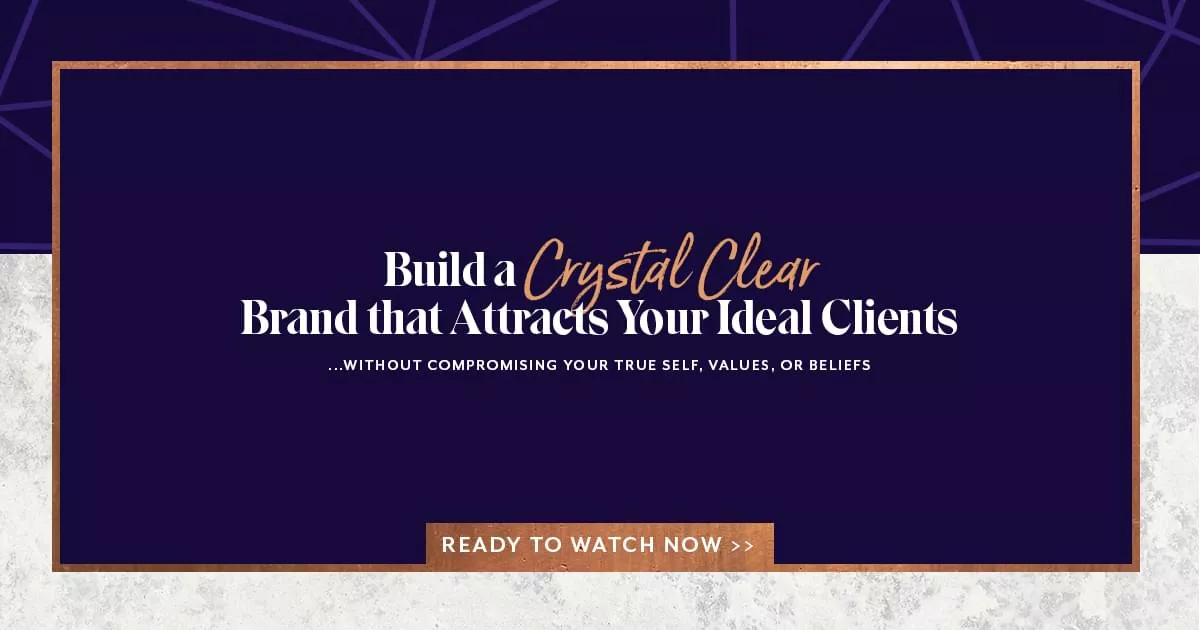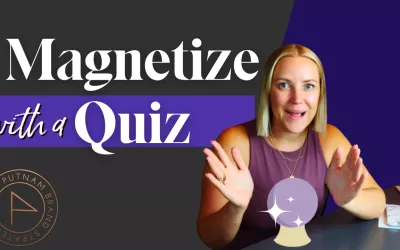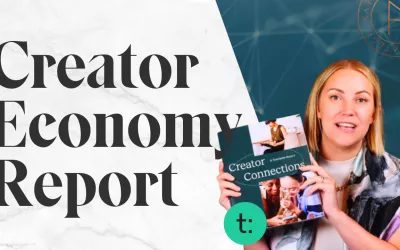Watch out, dear reader! This webpage is hot. 🔥
Because today I’m spilling the scalding hot tea about my proprietary 4C branding process – the framework I use to build compelling brands.
If you’re an entrepreneur with a burning desire 😉 to make an impact with what you create and know – and you want to make a good living doing it! – you’re going to want to hear this.
My 4C framework is what I use to facilitate the oh-so-critical work of building a strong brand foundation. I use it to co-create with my 1:1 clients (who pay between $10K and $30K to work with me). It’s also the basis for Brand New Brand, my brand incubation program for entrepreneurs making less than $100K in revenue annually.
Ready for the tea?
Amazing! ‘Cause I’m ready to spill.
🎥 (Oh, and… it’s important to me that I serve up the tea – errr, this lesson – 😉 in the way that’s most digestible for YOU. So, if you prefer to watch it, you’ll find a video version below. Or, read on for the details…)
First, why do some businesses thrive – and others fizzle?
To give you some background on where the 4C process came from, I want to share the question that prompted me to write this article.
A genius entrepreneur who participated in my recent free 4-day challenge asked me this question:
“Curious, Kaye… What’s the difference between branding and marketing? And how did you decide to focus on helping business owners with branding?”
🤓 The nerdy research girl on my left shoulder said, “Kaye, see what the AMA (American Marketing Association) website says… Or, think back to the college textbooks.”
🤩 Then, the “pragmatic Kaye” on my right shoulder said, “You already know; you don’t need to research it. Just tell her.”
“Pragmatic Kaye” was right, so I when wrote back, I started with this simple definition:
“Your marketing is what you do and how you help. Your brand is who you are… and your unique messages are at the intersection.”
Then I went on to answer the other half of her question, revealing part of my very own genesis story…
Back in the day (when hot tea was just a drink 😉 )… I used to work for a traditional media company – a radio group in Tennessee. I noticed, through my work there with advertisers, that some businesses were able to cut through all of the noise – and scale and thrive. Meanwhile, others failed to gain traction… and fizzled out.
And I wanted to understand why. 🧐 (Truth be told, I was sort of obsessed with it!)
For example, I observed that some radio campaigns and spots delivered major results, while others flopped. Some of the flops were ads for fantastic businesses, and we were applying the same basic principles to the campaign creation and delivery. Vexing.
So I was trying to identify the common denominators. And the patterns I saw were *not* about how much passion the people who ran these businesses had, or whether they were good at their work… Nope. The bottom line was this:
💥 The businesses that made sales and succeeded had strong brands. 💥
They had done the work to get clear and certain on who they were and what their values and opinions were. They were confident and knew *exactly* how they wanted to show up in the world. People knew what these brands stood for – and the right people made emotional connections to them.
So, that’s how I really learned that a strong, clear, compelling brand makes marketing (and everything else!) work better. And I got hooked on helping define and build those strong brands.
So through all of the agency experience that I’ve had in the last decade and a half – and now with working with my students and my one-on-one clients – I have worked behind the scenes of more than 500 brands. So, I’ve had the honor and the privilege to see what works and what doesn’t work – and what matters and what doesn’t matter.
And that is the basis for my four-C process for branding.
Ready for it? Okay, without further ado… Let’s learn.
Pin this article to reference later! 📌

Pin this article to reference later! 📌
The first ‘C’ is your brand’s Character.
The character your brand plays is incredibly important. David Ogilvy, the founder of the legendary Ogilvy and Mathers Ad Agency said,
“… You now have to decide what ‘image’ you want for your brand. Image means personality. Products, like people, have personalities, and they can make or break them in the market place.”
Essentially, people want to connect with other people, not just with products. So, If you want the right people to pay attention to you,
it’s critical that your brand embodies a character – one that will resonate with them on a human level.
And there are two keys to defining your brand character – Personality and Point of View. Let’s look at each one.
If you are familiar with my work, you likely know that the Brand Archetypes are my tool of choice for choosing and defining your brand’s personality. You can learn more about the archetypes here, but in a nutshell… By choosing and leveraging archetypes, you are using a common language of association that all humans share. This helps us tap into particular emotions in our audiences, and helps us trigger gut-level responses that can shortcut connection – and shorten the sales cycle.
So are you caring? Are you rebellious? Or entertaining, super driven, ambitious, and / or something else? These decisions contribute to the character of your brand. The archetypes help pinpoint these and translate them to your brand’s outward cues.
Meanwhile, your brand’s unique point of view is the other half of the equation and contributes to its character. This means knowing and articulating what you believe as a brand.
Your strong opinions and beliefs are what will get people to stand up and pay attention to you. And they serve to draw in the people that you want to work with – and repel the people that aren’t a good fit for you.
(One thing I’ve learned in my work though, is it’s not always easy for us to identify and live our strong opinions out loud. Many of us have been conditioned to stay ‘vanilla’ and blend in or adapt to the crowd – which is the last thing you want to do as a brand-builder – especially in a competitive market. If you want to work on articulating your opinions – for the sake of your brand and your wallet 🤓 – here are some exercises that will help!)
Up next in the 4 C’s…
The second ‘C’ is your brand’s Commitment.
Your brand’s commitment answers this question: What do you sell – and to whom?
You cannot build a business if you don’t know what you sell. Sounds obvious, right? But it shouldn’t be taken for granted, because a clear and aligned set of offers = a value proposition people understand.
I often say, “A confused mind doesn’t buy” and it’s so relevant here. You have to be *crystal clear* about what you offer, what results your product or service delivers, and who it’s for.
If you’re not clear, no one will take notice – or take action. They’ll just look at you quizzically and keep on walking… (In the digital world, the equivalent is crickets when you promote, and a lot of “I’ll keep you in mind for the future…”)
But, what if you don’t know exactly what you sell? ( ← That is okay. Nothing to be ashamed of. It’s just time to get clear on it. And the branding process will actually help you achieve that clarity!)
You have to start somewhere. Start with an inkling of what you are going to sell – whether that’s a product, a service, a course, a non-profit, and idea… and engage in the branding process to refine it.
You’ll also need to define who your most ideal customer is – for now. This will evolve over time too, because the best (only?) way to learn who you want to work with… is to work with people. (🐓/ 🥚, I know! But it’s true.)
For more on defining who you want to work with – and who you don’t (and why it’s kind of like dating!) – check out this article.
The third ‘C’ is your brand’s Credibility.
Cool. So, you say you help ___________ get __________ results by delivering ______________.
But why should we believe you?
People make buying decisions emotionally first – but they also back them up with logic, especially right before they hit that “buy” button.
Luckily, there are many ways to build credibility – even some that you can leverage when you’re just getting started! They generally fall into one of two categories.
Category one is the hard proof, like:
- You have testimonials from past customers – in their own words – attesting to the results you helped them get.
- You’ve published case studies that tell the stories of those customers’ experiences – and showcase the transformations and improvements.
- You have credentials that show you are experienced and/or expert – like certifications, formal education, licensure.
Category two is implied credibility, and it can be equally impactful.
Examples:
- Your brand and design (website, social posts, sales pages, etc) are impeccable, so it follows that you are well-established and expert.
- You’re very informed and articulate. You know exactly what you’re talking about, so people naturally trust you.
- You’ve been published or featured in respected journals or at events or the like, or third-parties have endorsed you.
- You have famous friends; you get to enjoy their credibility by association.
So, part of the 4C brand-building process is identifying and bringing forward the evidence that you can fulfill on the brand commitment in #2 above.
The fourth ‘C’ is your brand’s Context.
The last C is the context that your brand lives in – and there are two levels of context that I focus on with clients and students.
The first is the market-level context. Who else is serving your ideal client in this market? Who or what could be a substitution for your service or product? And how are you different – not better – from that market level?
Second, underneath that level, is the cultural context. Think about this in this way… You’re operating your business in a very specific time and place.
So think about the trends, or the forces that are changing in the world right now. What forces affect things in your industry? How do people perceive your industry, in general? What role are you playing? That all plays into the cultural context.
(Personal note: Cultural context has been on my mind A LOT at the time I’m publishing this article in March of 2020. When I outlined this via video months ago, I said this:
“If our world went to hell in a handbasket next week, and there was a zombie apocalypse, chances are you wouldn’t be running the same business in the same way.” 😳
Now, when I go to write this, the COVID-19 outbreak has started to impact life and online business in ways I could not have imagined back when I riffed on this topic.
The answers to aaaallll of the questions above… How are current events affecting entrepreneurs and the online business space? How can entrepreneurship be a blessing? What role am I playing in helping people? How are my clients and students helping people? … These are top-of-mind for me as I find the best ways to serve my audience at this crazy time! I wrote some thoughts on it here.)
Okay, back to the regularly scheduled programming…
So… what happens if you skip the “process?”
Now, in case you’re thinking… Can’t you simply hire a really talented designer and ask her to conjure up a sharp brand for you? (In other words, can’t you outsource this whoooooooole branding thing?)
Or, can’t you just pick some colors and a logo and assume it will serve your business well?
The answer is a big NO. Niet. Nahi. Heck no. 😐
Because you can’t outsource vision. (You can outsource brand assets, of course. But the foundational work? Not so much.)
In fact, the biggest mistake that I see brand-builders make? It’s when they skip straight to the visuals – without doing the work to establish a foundation. When I hear someone say, “Design me a logo! I want some colors, and some fonts, and I wanna look really good!” I feel really concerned for him, because I know what’s in store. 😔
If he skips to the visuals, he likely won’t end up with a brand that is based on truths.
It won’t feel like him – or truly represent his genius.
It won’t anchor him in the confidence and certainty an entrepreneur needs to be successful.
It won’t be clear or magnetic.
It won’t attract his ideal audience.
And he’ll outgrow it FAST – and feel the itch to re-brand again in a few months… All because he didn’t take the time to figure out what the foundation of his brand strategy would be.
So, the long and short of it is this: Do the work first, and you get a brand that is timeless and built on your truths… A brand that works, and that actually attracts your ideal clients to you.
Wondering how to get started? How about here? 👇 👇 👇
You can create your *Crystal Clear* 1-Page Brand Plan with me – in my FREE “Define Your Brand” Masterclass. It’s the perfect way to get into action and build momentum for your own brand-building process.
Sign up and learn – for free —-> by clicking here!





